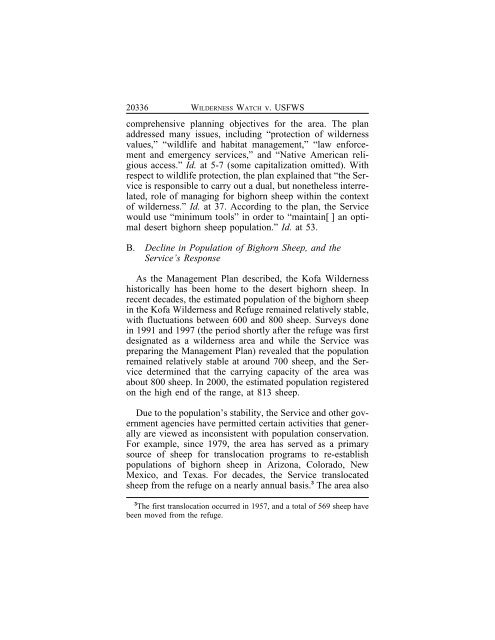WILDERNESS WATCH v. USFWS - Ninth Circuit Court of Appeals
WILDERNESS WATCH v. USFWS - Ninth Circuit Court of Appeals
WILDERNESS WATCH v. USFWS - Ninth Circuit Court of Appeals
You also want an ePaper? Increase the reach of your titles
YUMPU automatically turns print PDFs into web optimized ePapers that Google loves.
20336 <strong>WILDERNESS</strong> <strong>WATCH</strong> v. <strong>USFWS</strong><br />
comprehensive planning objectives for the area. The plan<br />
addressed many issues, including “protection <strong>of</strong> wilderness<br />
values,” “wildlife and habitat management,” “law enforcement<br />
and emergency services,” and “Native American religious<br />
access.” Id. at 5-7 (some capitalization omitted). With<br />
respect to wildlife protection, the plan explained that “the Service<br />
is responsible to carry out a dual, but nonetheless interrelated,<br />
role <strong>of</strong> managing for bighorn sheep within the context<br />
<strong>of</strong> wilderness.” Id. at 37. According to the plan, the Service<br />
would use “minimum tools” in order to “maintain[ ] an optimal<br />
desert bighorn sheep population.” Id. at 53.<br />
B. Decline in Population <strong>of</strong> Bighorn Sheep, and the<br />
Service’s Response<br />
As the Management Plan described, the K<strong>of</strong>a Wilderness<br />
historically has been home to the desert bighorn sheep. In<br />
recent decades, the estimated population <strong>of</strong> the bighorn sheep<br />
in the K<strong>of</strong>a Wilderness and Refuge remained relatively stable,<br />
with fluctuations between 600 and 800 sheep. Surveys done<br />
in 1991 and 1997 (the period shortly after the refuge was first<br />
designated as a wilderness area and while the Service was<br />
preparing the Management Plan) revealed that the population<br />
remained relatively stable at around 700 sheep, and the Service<br />
determined that the carrying capacity <strong>of</strong> the area was<br />
about 800 sheep. In 2000, the estimated population registered<br />
on the high end <strong>of</strong> the range, at 813 sheep.<br />
Due to the population’s stability, the Service and other government<br />
agencies have permitted certain activities that generally<br />
are viewed as inconsistent with population conservation.<br />
For example, since 1979, the area has served as a primary<br />
source <strong>of</strong> sheep for translocation programs to re-establish<br />
populations <strong>of</strong> bighorn sheep in Arizona, Colorado, New<br />
Mexico, and Texas. For decades, the Service translocated<br />
sheep from the refuge on a nearly annual basis. 3 The area also<br />
3 The first translocation occurred in 1957, and a total <strong>of</strong> 569 sheep have<br />
been moved from the refuge.

















